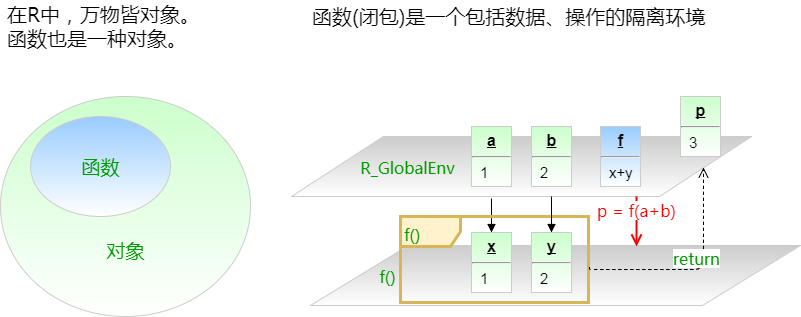2017-08-02 20:39:39
目录
知识扩展
函数的结构
R有两类函数: 闭包(closure)和内置(primitive)函数
闭包
- 由R代码写成
- 包括3部分: 形参(formals, 即arglist)、函数体(body)和环境
- 和普通R对象一样,也有attributes、class等属性
function (arglist) expr return(value)
内置函数
- 由C语言写成,通常内置于base包内
- 没有形参(arglist)、函数体(body)和环境
- 没有attributes、class等属性
function (arglist) .Primitive(method)
例子
- 构造一个自定义函数addN
addN <- function(x, n=1) return(x+n) formals(addN)
## $x ## ## ## $n ## [1] 1
body(addN)
## return(x + n)
environment(addN)
## <environment: R_GlobalEnv>
- 查看内置函数sum
sum
## function (..., na.rm = FALSE) .Primitive("sum")
formals(sum)
## NULL
body(sum)
## NULL
environment(sum)
## NULL
函数、对象、环境

f <- function(x, y) {
print(list("本闭包环境"=ls()))
print(list("上一层环境"=ls(envir=parent.frame())))
return(x+y)}
a <- 1; b <- 2
当前环境有些什么对象?
list("当前环境"=ls())
## $当前环境 ## [1] "a" "b" "f"
运行f()函数,该闭包环境里有些什么对象?
f(a, b)
## $本闭包环境 ## [1] "x" "y" ## ## $上一层环境 ## [1] "a" "b" "f"
## [1] 3
作用域
- 作用域(scoping)的概念会在B01_04讲
f <- function(x) x + y y <- 10
函数定义中找不到y,则到上一级环境中找
f(1)
## [1] 11
如果找到R_GlobalEnv仍找不到,则返回错误
rm(y) f(1)
Error in f(1) : object 'y' not found
操作皆函数
“To understand computations in R, two slogans are helpful:
- Everything that exists is an object.
- Everything that happens is a function call."
— John Chambers
代数算符
x <- 5 y <- 3 c(x + y, `+`(x, y))
## [1] 8 8
all.equal(x + y, `+`(x, y))
## [1] TRUE
| 算符函数 | 等价于 |
|---|---|
| `-`(5, 2) | 5 - 2 |
| `*`(5, 2) | 5 * 2 |
| `/`(5, 2) | 5 / 2 |
| `%%`(5, 2) | 5 %% 2 |
| `==`(5, 2) | 5 == 2 |
这些也是函数
for (i=1:2) print(i)
`for`(i, 1:2, print(i))
## [1] 1 ## [1] 2
if (3>2) print("y") else print("n")
`if`(3>2, print("y"), print("n"))
## [1] "y"
连这些也是函数
`[`(1:5, 3)
## [1] 3
`[`(iris, 4, 5)
## [1] setosa ## Levels: setosa versicolor virginica
`[[`(as.list(1:4), 2)
## [1] 2
`{`(print("a"), print(3))
## [1] "a" ## [1] 3
`<-`(x, 4); x
## [1] 4
用函数自定义操作符
排列组合
`%A%` <- function(n, m) choose(n, m) * factorial(m) `%C%` <- function(n, m) choose(n, m)
5 %A% 3
## [1] 60
5 %C% 3
## [1] 10
函数参数
参数匹配原则
- 完整参数名精确匹配
- 参数名前缀模糊匹配
- 参数顺序匹配
f <- function(first, second, third=5)
c(first=first, second=second,
third=third)
f("a", TRUE)
## first second third ## "a" "TRUE" "5"
f(second="a", TRUE)
## first second third ## "TRUE" "a" "5"
f(t="a", TRUE, f=5)
## first second third ## "5" "TRUE" "a"
参数列表实践建议
函数作者
- 参数名称要意义明确,避免过长或过度缩写
- 无默认值的参数在前,有默认值的参数在后
- 最重要的无默认值参数放在最前面
- CRAN的附加包规范禁止使用参数模糊匹配,故尽量用参数全名
- 在…后面的参数,必须用完整参数名精确匹配
函数使用者
- 第一、二个参数不妨用顺序匹配,其余的尽量用精确匹配
- 尽量避免模糊匹配
参数缺失和默认值
f <- function(x, y) {
if (missing(x)) x <- 0
if (missing(y)) y <- 0
return(c(x, y))
}
f()
## [1] 0 0
等价于
f <- function(x=0, y=0) c(x, y)
限定参数取值范围
- 数值
f <- function(x=1:4) {
stopifnot(x %in% 1:4)
paste("out:", x[[1]])
}
f()
## [1] "out: 1"
f(6)
Error: x %in% 1:4 is not TRUE
- 非数值
f <- function(x=c("a", "b")) {
x <- match.arg(x)
paste("out:", x)
}
f()
## [1] "out: a"
f('c')
Error in match.arg(x) :
'arg' should be one of “a”, “b” dot dot dot (…)
...匹配所有的“其他”参数,可轻松地传递给其他函数- 用
list(...)捕获所有未匹配参数
- 用
...过于灵活,可导致参数跳过校验而不报错
f <- function(..., na.rm=TRUE) {
# 解析...参数
args <- unlist(list(...))
# 校验: 如不是全为数值,则报错
stopifnot(all(is.numeric(args)))
# 计算均值
mean(unlist(args), na.rm=na.rm)
}
f(1, 4, 6, 9, NA)
## [1] 5
f(1, 4, 6, 9, "m")
Error: all(is.numeric(args)) is not TRUE
f <- function(...){
args <- list(...)
if ("x" %in% names(args))
print(mean(args$x))
if ("y" %in% names(args))
print(sd(args$y))
plot(...)
}
f(x=1:5, y=log(1:5), col="blue", type="b")
## [1] 3 ## [1] 0.6355094

特殊调用
替换函数
- 形如
fun<-,具体用法为fun() <- - 事实上R生成了一个修改后的副本,然后才删除原本
library(pryr) x <- 1:10 address(x)
## [1] "0x3831270"
`revise<-` <- function(x, n, value) {
x[[n]] <- value
x
}revise(x, 5) <- 7 x
## [1] 1 2 3 4 7 6 7 8 9 10
address(x)
## [1] "0x36a4490"
- 等价于
x[5] <- 7(内置函数[<-) - 内部方法(primitive)可实现原位替换
- 拷贝修改机制有时可能导致内存溢出
返回值
- 函数返回
return()函数显式定义的值,并跳出调用栈 - 如没有
return,则返回函数最后一个求解出的值
f <- function(x, y){
if (x < y) {
"lower"
}else{
"higher or equal"
}
}
f(4, 3)
## [1] "higher or equal"
f <- function(x, y){
if (!all(is.numeric(x),
is.numeric(y)))
return(
"Must be both numeric!")
if (x < y) {
"lower"
}else{
"higher or equal"
}
}
f("a", 3)
## [1] "Must be both numeric!"
on.exit()
- 函数退出调用栈时,通过
on.exit()函数可触发钩子 - 通常用于重置状态,恢复运行前的设置
f <- function(x){
setwd("C:")
x
}
f(1)
[1] 1
getwd()
[1] "C:/"
f <- function(x){
old.wd <- getwd()
on.exit(setwd(old.wd))
x
}
f(1)
[1] 1
getwd()
[1] "/R_Tutorial/B01 FP And OOP"
Thank you!